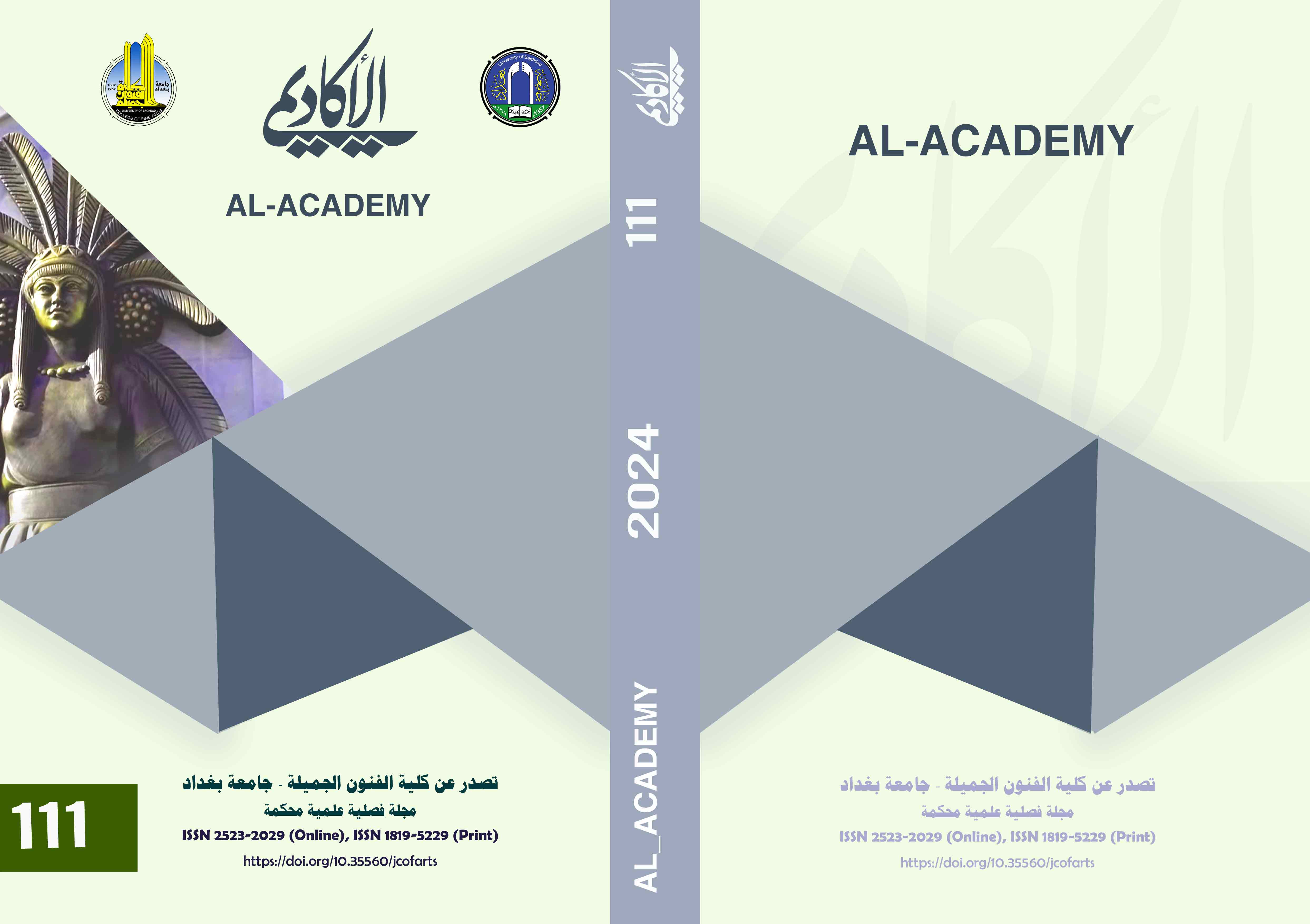The Elements of Tale in Contemporary Iraqi Painting (Khlaif Mahmoud As a Model)
DOI:
https://doi.org/10.35560/jcofarts1182Keywords:
tale, elements, paintingAbstract
The research dealt with the elements of the tale in contemporary Iraqi painting (Khlaif Mahmoud as a model). Where the research problem was identified by answering the following question: - Are the elements of the tale achieved in the works of the artist Khalif Mahmoud?
The research included four chapters, the first chapter dealt with the research problem, the research objective, and their objective, temporal and spatial limits. It followed by the terminology and procedural definition.
Chapter two included the theoretical framework that contained three sections. The first dealt with the concept of the tale and its components, the second one dealt with the tale from linguistic narration to narration in contemporary Iraqi painting, while the third dealt with the foundations of the tale in painting and its perspectives for the artist Khlaif Mahmoud.
Chapter three dealt with a presentation of the research procedures. As for chapter four, it included what was achieved of research procedures to reach the goals in light of the analysis of the approved samples, and the results came in which the artist relied on the style of modern realism and expressionism related to the popular heritage (the tale). The researcher also reached a number of conclusions, including that the tale is the product of a popular and cultural heritage that has been inherited by generations since the inception of creation and ended with the path and the biography of the artist.
References
Abd Al-Wahhab, T. A. I. (2012). Reading the plastic images between truth and imagination, Journal of Humanities and Economics, Issue 1, p. 108
Abu Zeina, A. (1993-2015). Voices of Civilization (Viewing the West Bank and the Gaza Strip (Content and Construction), E-Book Publications - London,).
Al-Amri, M. (2011). Al-Wan Iraqiya, Amman_Al-Jordan, Dar Al-Adeeb for Press and Publishing, Vol. 1, p. 15.
Al-Anbari, S. (2018). Al-Alam Magazine, Daily Life Waters, Al-Ahd_12. On the website:-. http: // www.alaalem.com
Al-Ansari, I. M. bin M. (1982). Lisan Al-Arab (Chapter Al-Haa, the letter Al-Waw and Al-Ya (Hakaya), Volume 17, Al-Mutaba Al-Kubra Al-Mudiria, 1st edition, Al-Miriya Press, Egypt.
Al-Jabouri, A. (2015). Article in Al-Zaman newspaper, July 26, On the website: http: // www.azzaman.com
Al-Nasir, Y. (1980). The novel and the place (a study in the art of the Iraqi novel, the small encyclopedia series 57, Dar Al-Hariya Printing House, Baghdad, p. 1.
Al-Obeidi, A. A. (2014-2016). The story between rooting and interpretation, a paper filed at the Center for Al-Mosul Studies, University of Al Mosul, pp. 7-1-20., p. 4.
Al-Qura-Gholi, M. A. A. (2013). The Narrative in the Contemporary Iraqi Formation, University of Babylon Hananiya, volume (21) number (1), p. 172.
Al-Rawi, Y. A. (1998). the location and form, Dar al-Adaab, Beirut, Lebanon, volume 1. p. 126
Al-Ta'i, M. (2019). Lights on the plastic movement in Nineveh, Amman, Al-Aderden, Dar Al-Adeeb Press, Volume 1, pp. 188_189.
Al-Zaghabi, Z. (1995). The place and the world in the novel Return to the North, Yarmouk Research Magazine, Yarmouk University, Arid- Jordan, Volume 12, Number 2, pp. 20-21.
Al-Zaidi, K. (2017). The structure of real art and identity discourse, Amman - Jordan, Dar al-Adeeb Press, vol. 1, p. 9.
Anis, I. (2004). The Mediator's Dictionary (Hakka article), Al-Lugha Al-Arabiya Forum, Al-Sharoq International Library, Vol. 1, i. 4 p. 42.
Bahrawi, H. (1990). The Structure of the Novel Form (Judgment, Time, Personality), Arab Cultural Center, vol. 1, Beirut, Dar Al-Bayda, p. 29.
Behieh: K. M. (2011). Al-Wan Iraqi, Amman_Jordan, Dar Al-Adeeb for Press and Publishing, Volume 1, p.6
Beljanan, N. and Budohin, S. (2014-2016). Techniques and techniques of the short story and its characteristics by Ahmed Reza Hoho, University of Abd al-Rahman Meerah, pp. 1-7-20.
Bin-Hajj, M. (without Year) The Short Story, Analytical Methodology and Its Characteristics, Al-Souqar, Qadiri Khaled High School, p.1
Bou Ezzah, M. (2010). Analyzing the Narrative Text, Al Arabi Dar for Uloom Publishers, Beirut - Lebanon, Volume 1, p. 87.
Fathi, I. (2000). Dictionary of Literary Terms, Dar Al-Sharqiat for Publishing and Distribution, Volume 1, p. 105.
Forster, A.M. (1960). The Elements of the Story, T. Kamal Iyad Gad, Karnak Publishing House, Ramses Building (Bab Hadid), Cairo, p. 36.
Ghazvan, M. A. (2007). Cultural Refuge (Readings in Art and Design) Baghdad Dar Magdalavi Publishing and Distribution, p. 107.
Hilal, G. (without Year) Modern Literary Criticism, Dar Al-Nahda for Printing, Publishing and Distribution, B.T., p.5004.
Jadeli, N and Sharifi, Z. (2017-2018). The short story between commitment and rebellion - a comparative study - between the views of the Manfaluti and the rebellious spirit of Gibran Khalil Gibran, Mohamed Boudiaf University, pp. 11, 8, 4.
Jandari, I. (1992). Al-Mosul, the narrator, Al-Asar, the Mi'ezna, and the brutal Nahareh dawn, Al-Iqlam magazine, Baghdad, numbers 7-8, p. 56.
Karam, S. A. (2020). Tale craft (a theoretical and practical guide to writing the novel), Dar Al-Mayadeen Publishing and Distribution, p.24
Kofi, A. (2011). Al-Wan Iraqi, Amman_Jordan, Dar Al-Adeeb Press and Publication, Vol. 1, p. 12.
Ruwaq Al-Taskhleh magazine (2018). published by the Iraqi Plastic Artists Association, Baghdad, the fourth issue, the first year, Nisan p.89_90.
Saleh, R. (1997). The Language of Plastic Art in the 20th Century, Alem El Fekr Magazine, Kuwait, Volume 26, Number 2, p. 81.
Wahby, M. and Al-Mohandis, K. (1979). The Dictionary of Arabic Terms in Language and Literature, Lebanon Library, Beirut, p. 152.
Yaqtin, S. (1989). Analyzing the narrative discourse (techniques and concepts), Cultural Center, Beirut, Dar Al-Bayda, i1, p. 59.
Downloads
Published
Issue
Section
License
Copyright (c) 2023 Nour Khalif Mahmoud

This work is licensed under a Creative Commons Attribution 4.0 International License.













